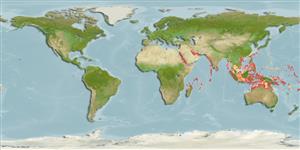Environment: milieu / climate zone / depth range / distribution range
Ecology
Marine; reef-associated; depth range 10 - 15 m (Ref. 90832). Tropical; 22°C - 26°C (Ref. 27115); 30°N - 18°S
Western Indian Ocean: Red Sea and adjacent areas. Elsewhere in the Indo-West Pacific refers to Lotilia klausewitzi.
Size / Weight / Age
Maturity: Lm ? range ? - ? cm
Max length : 3.1 cm SL male/unsexed; (Ref. 90832)
Short description
Morphology | Morphometrics
Dorsal
spines
(total): 7;
Dorsal
soft rays
(total): 9;
Anal
spines: 1-9;
Anal
soft rays: 9;
Vertebrae: 26. This species is distinguished by the following characters: no cephalic sensory canals and pores; sensory-papillae row 4i not extending ventrally beyond a horizontal line through posterior end of row d; right and left sides of row n are not close to one another, with a broad interspace between them; branched caudal-fin rays 7+7=14; pale area on dorsum from snout to dorsoanterior part of body is relatively long, extending posteriorly to around base of third or fourth spine; presence of a conspicuous ocellated black spot with vivid pale margin at center of first dorsal fin, extending anteriorly beyond third spine; absence of a submarginal row of black spots on caudal fin (Ref. 90832).
Found only on sandy areas, and symbiotically associates with a snapping shrimp, probably Alpheus djiboutensis where it swims freely at ca. 10-15 cm above the nest hole as it moves its pectoral fins alternately. It was also reported that, in the northern Red Sea, it is associated with an unidentified Alpheus species which is not A. djiboutensis (Ref. 90832).
Life cycle and mating behavior
Maturity | Reproduction | Spawning | Eggs | Fecundity | Larvae
Shibukawa, K., T. Suzuki and H. Senou, 2012. Review of the shrimp-associated goby genus Lotilia (Actinopterygii: Perciformes: Gobiidae), with description of a new species from the West Pacific. Zootaxa 3362:54-64. (Ref. 90832)
IUCN Red List Status (Ref. 130435)
Threat to humans
Harmless
Human uses
Aquarium: commercial
More information
Common namesSynonymsMetabolismPredatorsEcotoxicologyReproductionMaturitySpawningSpawning aggregationFecundityEggsEgg development
Age/SizeGrowthLength-weightLength-lengthLength-frequenciesMorphometricsMorphologyLarvaeLarval dynamicsRecruitmentAbundanceBRUVS
ReferencesAquacultureAquaculture profileStrainsGeneticsElectrophoresesHeritabilityDiseasesProcessingNutrientsMass conversion
Tools
Special reports
Download XML
Internet sources
Estimates based on models
Preferred temperature (Ref.
123201): 25.3 - 29.1, mean 28.1 °C (based on 488 cells).
Phylogenetic diversity index (Ref.
82804): PD
50 = 0.7500 [Uniqueness, from 0.5 = low to 2.0 = high].
Bayesian length-weight: a=0.00708 (0.00333 - 0.01504), b=3.09 (2.92 - 3.26), in cm total length, based on LWR estimates for this (Sub)family-body shape (Ref.
93245).
Trophic level (Ref.
69278): 3.1 ±0.3 se; based on size and trophs of closest relatives
Resilience (Ref.
120179): High, minimum population doubling time less than 15 months (Preliminary K or Fecundity.).
Fishing Vulnerability (Ref.
59153): Low vulnerability (10 of 100).
Nutrients (Ref.
124155): Calcium = 238 [101, 517] mg/100g; Iron = 1.04 [0.49, 2.11] mg/100g; Protein = 17.7 [15.7, 19.5] %; Omega3 = 0.106 [0.042, 0.228] g/100g; Selenium = 27.4 [10.9, 69.2] μg/100g; VitaminA = 147 [37, 574] μg/100g; Zinc = 2.86 [1.75, 4.42] mg/100g (wet weight);
